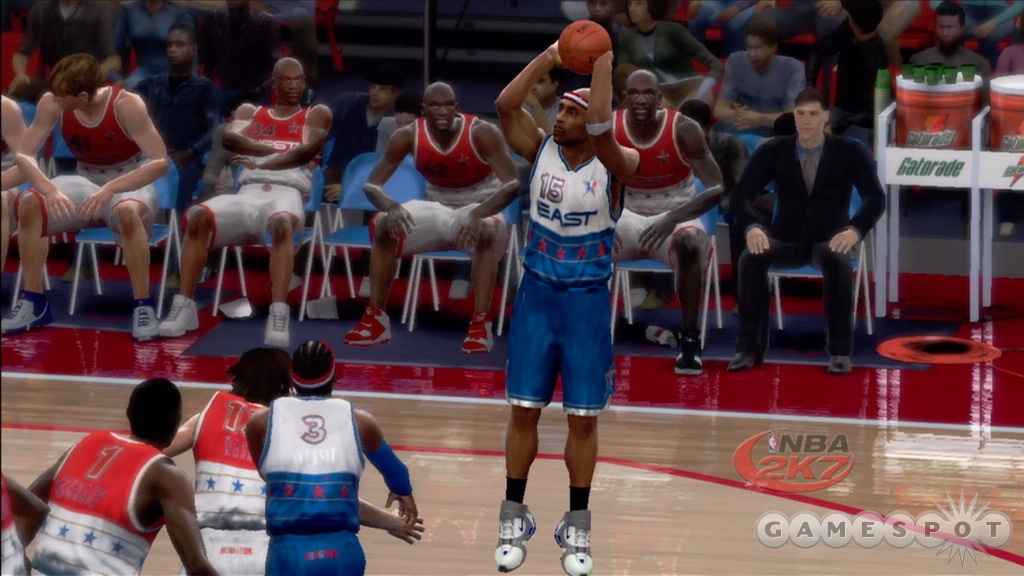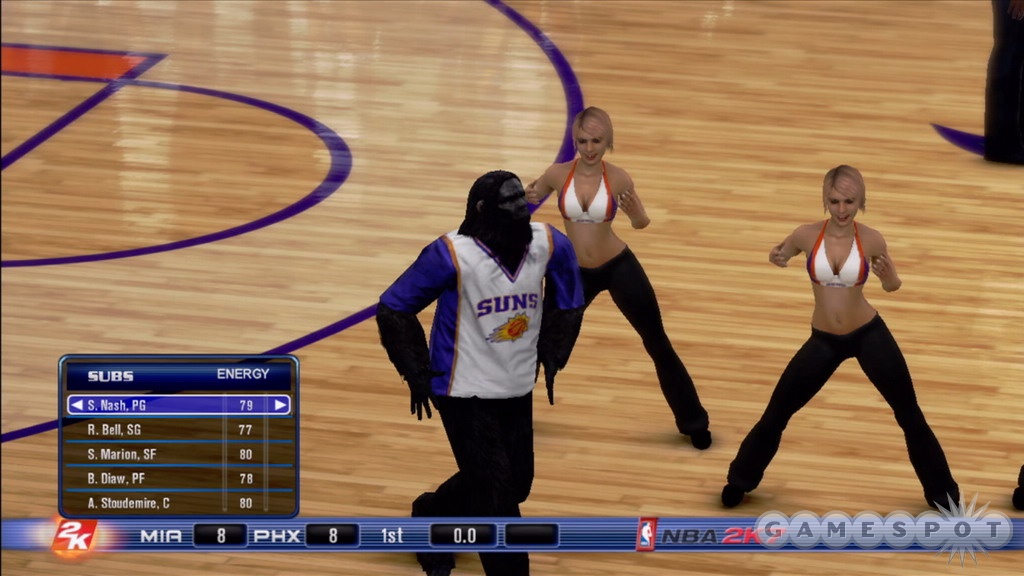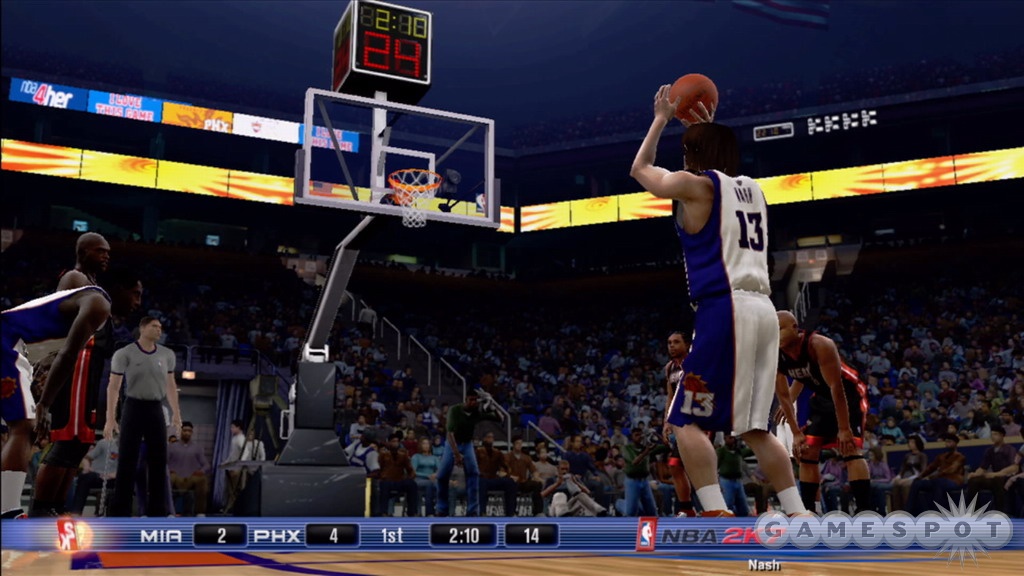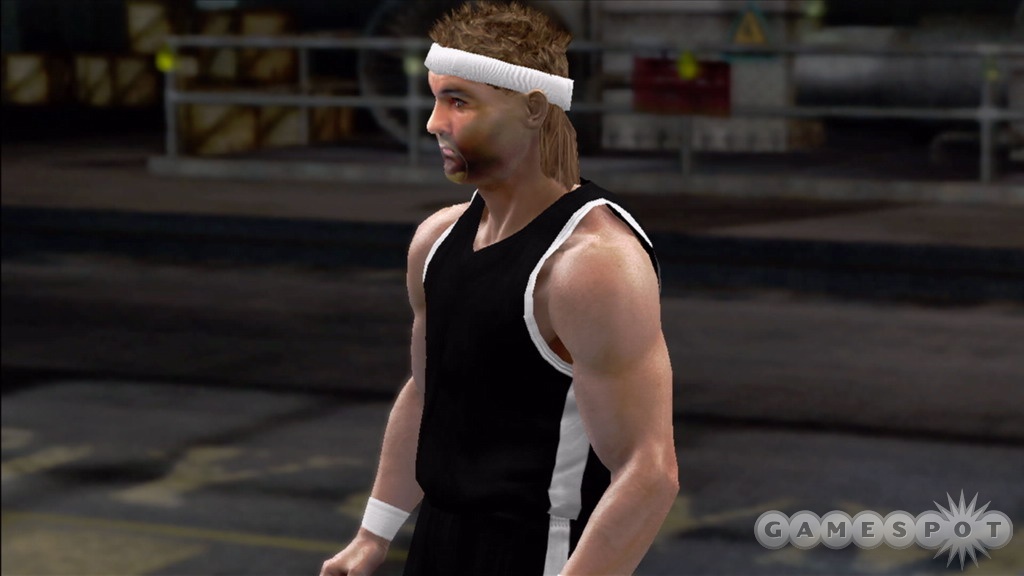Neither NBA 2K6 nor NBA Live 06 were quite able to meet people's high expectations when they came out during the Xbox 360's launch last November. Live had sharp graphics and snazzy presentation but not much in the way of substance, while 2K6 was a prettier, slightly enhanced version of what had been released on the Xbox and PlayStation 2 a few months earlier. With Visual Concepts having an entire year in development, hopes were high for NBA 2K7. Perhaps too high. Sure, there are oodles of new animations and gameplay options, but many key issues went untouched. It's still a great choice for anyone who likes a realistic pace to their NBA video games, but it's not the defining basketball simulation that many were hoping for.

NBA 2K7 features a dizzying number of gameplay modes. Quick play, 24/7, season, the association, tournaments, and a robust online component give the game tremendous replay value. There are also a number of options and sliders that let you tweak the game to your heart's content. Having so many choices to pick from is great, but navigating through all the modes and options is made needlessly difficult due to the new menu system. It's unreasonably complex, and you're forced to bring up menus with the right analog stick. Rarely are you able to simply go back a step; rather, you're forced to go all the way back to each mode's main menu and do things all over again.
The association is NBA 2K7's multiseason mode, and it's deeper than ever. You're placed in charge of an NBA franchise and it's your job to hire coaches, set up practices, perform general manager duties, and play the games. Watching your team's chemistry as well as fatigue level is very important, since players will tire after hard practices, thereby not giving you their best effort during a game. Should you need to shake things up in the locker room, three player trades are now supported, though to be honest, we spent 30 minutes trying to pull one off without success. You'll also need to prepare for the NBA draft by scouting players and even putting them through a series of predraft workouts. One thing's for sure--there's never a lack of activities to keep you occupied. For such a complex simulation, the association runs smoothly, without any major glitches. Dwayne Wade did win the MVP five seasons in a row, but other than that anomaly, player statistics seemed realistic and players retired at reasonable ages.
24/7 mode has received a face-lift, and while it doesn't hold a candle to NBA Street, it's surprisingly robust for a secondary game mode. Improved create-a-player options allow for some crazy-looking characters, such as a mullet-haired baller that would make Joe Dirt and Randy Johnson jealous. New street-specific moves like bouncing the ball off an opponent's head and some over-the-top dribbling have been added, giving the game a decidedly arcadelike feel. There's a story that accompanies your player's rise to street-ball glory, but its execution is downright embarrassing. You're a young no-name baller who happens to be on the court while Shaq is practicing free throws. Somehow your buddy is able to talk Shaq into letting you shoot against him, and after you win, O'Neal hands you a flier with details on a legends tournament in New York. The combination of a corny script, so-so voice acting, and silent NBA players who act out their parts like mimes make the story difficult to enjoy. If you're looking for a street-ball experience without the story, you can play one-on-one, 21, and half- or full-court in locales from Miami to New York's Rucker Park.
On the court, Visual Concepts didn't make any huge alterations to how the game plays. Newcomers will likely find the controls difficult to pick up, while series veterans will appreciate them for their seemingly endless depth. Player substitutions, play calling, and more can be done during play by pressing the appropriate direction on the D pad. Effective use of set plays is an integral part of getting open shots, partially because that's how real NBA teams do it, but also because players move around the court as if getting open and cutting to the hoop aren't high on their list of things to do. Crossovers, spins, and hesitation moves are done via the "isomotion" controls (right trigger plus the left analog stick). Shooting is mapped to the X button, or, should you prefer, you can utilize the right analog stick for greater shot control. In theory, using the right analog stick to shoot lets you pick the best shot for the situation. A shorter guard posting up a power forward might want to opt for a fadeaway, while a taller player might go up strong and attempt a power dunk. In reality, using the analog stick results in players frequently putting up unnecessary low-percentage shots, rather than the simple shot you were hoping for.
Final scores and shooting percentages are noticeably lower this year, in part because teams play like their real-life counterparts. One night you might put up a bunch of points against Phoenix, which loves to push the tempo, and the next evening put up far fewer against the slower-paced Spurs. There's also an ugly side as to why scores are so low. Sometimes defenders legitimately play great defense, but just as often you'll skate in place, performing crossovers and hesitation moves against an invisible wall. Down low, the hop step is an effective way of establishing dominance in the paint, but it, too, is often rendered useless by unseen forces. Fast breaks are prone to coming to a screeching halt, either from a turnover due to an errant pass, forced because the camera was too close, or because of streaking players stopping in their tracks to receive a pass. The big way in which the game seems to keep scoring down is with an inordinate amount of missed shots. Blown dunks and lay-ups, wide-open three-pointers clanking off the rim, and missed put-backs are all commonplace. A few tweaks to the gameplay sliders can correct the anomalies, but that shouldn't be necessary.
For a game that bills itself as "the next-generation champion," 2K7 has some significant problems. The artificial intelligence is spotty, with point guards dribbling away 10 to 15 seconds at a time if left unguarded at the top of the key, and players constantly rotating into mismatches. It's not uncommon to see a center guarding a point guard or vice versa. Not all of the AI is bad. When the computer is on defense, defenders will fight through picks, rotate quickly, and double-team the hot player. Players also have a difficult time picking up loose balls--they'll just stand there and watch the ball roll around. When someone dives to the floor to get a ball (99 percent of the time it's the computer), there doesn't appear to be any sort of animation for a defensive player to try and tie them up. Everyone will just mill about as the player on the floor sits there looking for someone to pass to.
Free throws are performed by pulling down on the right analog stick to start the shot, and then letting up to shoot. This is exactly how they were done last year, but something has gone awry over the last ten months, because free throws have suddenly become extremely unwieldy. Whereas it was easy to shoot 85-90 percent in NBA 2K6, you'll be lucky to shoot 50 percent from the charity stripe in 2K7. Because of the large number of unique shots, you're forced to adjust your timing for each and every player, a difficult task made more difficult because of the ever-changing camera. You'll shoot one shot from one angle, and your second shot from another, making it tough to figure out exactly when to let up on the right stick. There's a practice mode, but you're shooting from yet another perspective, meaning success on the practice court doesn't translate to success during a real game. Unless you like losing close games because you missed 15 free throws, you'll want to adjust the free throw slider straightaway.

2K7's online play is a great example of how to do sports right on Xbox Live. Whether it's a quick game of one-on-one, a tournament, exhibition, or a fully-featured league you're looking for, NBA 2K7 has got you covered. The league option lets you set up and customize an online season for up to 30 players. You can allow trades, upload preferred slider settings, and even set how long people have to play their games--it's incredibly deep. You're able to check out other player's VIP profiles and even scout their playing tendencies. Should you run into a jerk, a brief series of postmatch questions will let you leave appropriate feedback. All of the options in the world don't mean a thing if the game doesn't play well online, but there's no need to worry--the game runs smooth and is very playable. NBA 2K7 has downloadable premium content in the form of a video-editing tool called the 2K ReelMaker that lets you save replays, add effects, captions, and music to them, and then lets you upload them to share online. It's not available yet, but the teaser trailer clearly says it must be purchased.
Because all 1,000 points could easily be earned in one game, NBA 2K6 has a special place in the hearts of achievement fiends everywhere. It's not nearly as easy this time. The 50 achievements are spread over a variety of gameplay accomplishments and will require a great deal of perseverance to acquire. Some achievements focus on getting a specific stat line from star players like Shaq, Kobe Bryant, Ben Wallace, or Tim Duncan, while others reward online prowess and even winning specific team rivalries on the Hall of Fame difficulty.
Perhaps the most noticeable, and certainly the most talked about, visual changes this year are the new signature style animations. The developer went through the arduous task of adding hundreds of new player-specific moves, so you'll see Shawn Marion's awkward-looking jump shot, Yao Ming's unique free throw, and Kobe Bryant's unmistakable fadeaway. Basketball aficionados will no doubt love seeing their favorite player's shot accurately re-created for the first time, but casual fans probably aren't going to notice a whole lot of difference between players' individual shots, outside of the big stars, unless they're watching a replay or shooting free throws.
The rest of the graphics are on par with last year, meaning they're generally excellent, but also starting to show their age a bit. As usual, the player animation is outstanding. There are lots of little touches that go a long way toward making it feel as though you're watching a real NBA game. Players move and react realistically to the action and will move their heads to track the ball as it's in the air, and they'll try to tip a just-out-of-reach rebound to keep it alive. You'll also notice players exhibiting more emotion--raising their hands in shock at being whistled for a foul, and hanging on the rim for emphasis after throwing down one of the game's fantastic looking dunks. The arenas are another highlight, accurately modeled and full of life. Cool things to look for are mascots and cheerleaders performing during timeouts, fans milling about the arena, and the referees signaling that a ball has been tipped on a shot.
Most of the popular players are instantly recognizable and look realistic. Lesser-known players aren't so lucky, and often look downright hideous. Player sweat and jersey movement appears to have been toned down a bit, and looks great. Those with a keen eye will notice that while both Kobe (24) and Amare (1) are sporting their new numbers, Steve Nash is still rocking his long hair from last season. As longtime fans of the series have come to expect, the frame rate is fast and silky-smooth. Of course, the same people who have grown to expect a smooth frame rate won't be surprised to learn the game suffers from frequent clipping problems, particularly during replays. The $30 difference in price between the Xbox 360 and Xbox versions make it worth noting that when viewed on a standard-definition television, the game looks considerably less impressive. This is something that budget-conscious gamers without access to an HDTV might want to consider if they still own an Xbox.
One area that went virtually untouched from last year is the audio. Kevin Harlan and Kenny Smith do a fair job calling the action, but they fail to offer a whole lot of analysis, and they're quite repetitive. Plan on hearing about how a team can get a "two for one" with 30 seconds to go nearly every quarter. Sideline reporter Craig Sager gives his canned spiel at the beginning of each half. Kenny Smith shows first-half highlights and gives his "stamp of approval" to the top performers during the halftime show. It's not particularly interesting, and you'll probably end up skipping it after just a few games, but at least it's there. The players are quite talkative on the court, yelling when they're open, calling out picks, and pointing out double-teams. 2K7's soundtrack features a hefty number of hip-hop tracks, though you'd never know it, since for some reason most of them are set by default to not play, forcing you to go into the options and turn them on.
When everything manages to come together, NBA 2K7 looks and feels amazing. Watching a player in the low post receive a bounce pass, pivot one way, take a drop step the other, and finally slam the ball home is truly something to behold. Unfortunately, these instances of perfection aren't as frequent as they could be, given the preponderance of nagging gameplay issues. Those who were expecting a big leap from last year will likely be disappointed, but fans expecting only a slight improvement, or anyone looking for a great, well-rounded basketball game, will be pleased with NBA 2K7.

